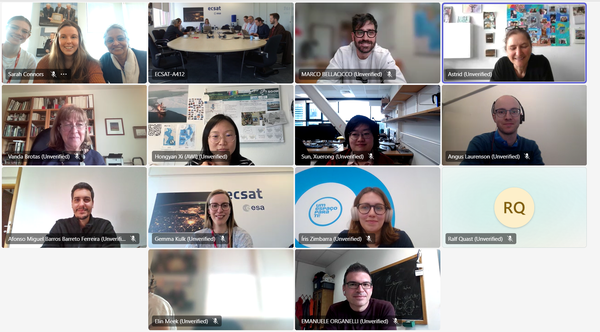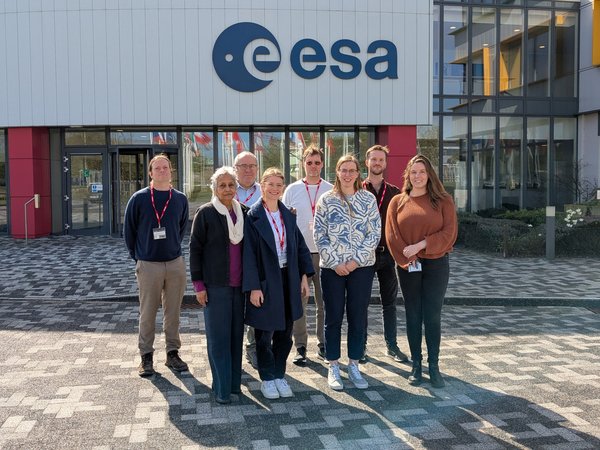Summary
The PHYTOplankton Biomass and Diversity Climate Change Initiative (PHYTO-CCI) project aims to develop satellite-based data products for two Essential Climate Variables (ECVs) identified by the Global Climate Observing System (GCOS): phytoplankton carbon biomass and pigment diversity. These variables are critical for understanding the structure and function of marine ecosystems, their role in the Earth system, and how they may be affected by global warming and other human-driven impacts.
Through the PHYTO-CCI project, satellite retrieval algorithms will be compared and combined using optical water classification to produce ECV products with associated uncertainty estimates. These products will be validated using both in situ and model data, followed by a comprehensive scientific assessment. The value of these new ocean biosphere ECVs will be demonstrated through their application in climate research and their relevance for supporting marine ecosystem services.
Background
Phytoplankton play a central role in the Earth System. Through photosynthesis, they are responsible for the uptake of 50 Gt C per year, equivalent to that of terrestrial plants, driving major processes in the ocean carbon cycle. Through this production of organic carbon, phytoplankton form the basis of almost all life in the ocean. Phytoplankton have high biodiversity – they are made up of thousands of species – and this is complemented by their functional diversity, which recognises that different types of phytoplankton play varied roles in marine ecosystems and in biogeochemical cycles of the ocean.
It is fitting that GCOS in their last revision of ECVs, has included phytoplankton in the new ocean biosphere ECV, together with zooplankton. Both phytoplankton biomass and diversity now constitute ECV products. For the development of ocean biosphere ECV products from satellite observations, we look towards the strong linkages with ocean colour observations as many of the satellite-retrieval algorithms developed for phytoplankton biomass and diversity use ocean colour data as their input variables. With many of the algorithms for phytoplankton biomass and diversity maturing over time, we are now in a position to produce such phytoplankton products to the ensemble of CCI ECV variables.
The ocean biosphere ECV will be a major contribution to the suite of ECV products of CCI. The products are high on the list of user requirements, because they are essential to better understand the functioning of the marine ecosystems, their contributions to shaping the Earth System (they are responsible for half the oxygen on this planet, after all), and to assess how these services might be changing under global warming and other anthropogenic impacts.
Project aims and objectives
The main objective of PHYTO-CCI is to provide novel products for phytoplankton biomass and diversity, that are identified as ECVs by GCOS and as essential ocean-colour products by the EO and ecosystem modelling communities, and that add value to the ESA CLIMATE-SPACE ECV development. We will produce ECV data products of phytoplankton carbon biomass and pigment diversity, including their uncertainties, using our experiences in OC-CCI and other CCI projects. They key objectives are:
- Specify ECV requirements by reviewing the requirements set out by GCOS for phytoplankton biomass and diversity and by consulting the climate research community.
- Develop novel blended algorithms for phytoplankton carbon biomass and pigment diversity by intercomparing and blending existing individual algorithms using optical water classes for production of the ECV data and their uncertainties. The products will be based on the continuous ocean-colour data record that is available since 1997, including seven different sensors (i.e., missions).
- Design a processing system for production of the phytoplankton biomass and diversity ECV products that makes use of existing capabilities of OC-CCI to ensure that the system could be implemented operationally.
- Validate ECV products through comparison with independent in situ data using quantitative and qualitative methods and through intercomparison with existing satellite-based and modelling products. A product user guide will be prepared for dissemination together with the ECV products.
- Assess quality of ECV products against GCOS and user requirements to improve the developed ECV products in the next production cycle. We will organise a dedicated user workshop to showcase the phytoplankton biomass and diversity ECV products and gather user feedback.
- Demonstrate value of ECV products in climate research and services through case studies focused on 1) addressing major gaps in ocean carbon research related to phytoplankton carbon, 2) analysing changes over time in phytoplankton groups, derived from pigment diversity, in the context of environmental change, and 3) evidencing the value of phytoplankton biomass and diversity data to inform fisheries as sustainable marine services.
- Collaborate internationally with scientists from relevant research projects, including CCI, and through participation in ESA colocation and Climate Modelling User Group (CMUG) meetings. We also actively pursue policy-related activities.
- Disseminate project results among the scientific community and the general public to maximise the impact of the project, by publishing in high-ranking peer-reviewed journals and by carrying out promotion, communication and policy-relevant activities.
Project plans
PHYTO-CCI is structured into six work packages (WPs), each addressing a key technical task.
WP1: Requirement Analysis will review user and GCOS requirements and refine the concepts proposed, this will feed into all subsequent WPs.
WP2: Algorithm Development is divided into two sub-work packages: WP2.1 Phytoplankton Biomass and WP2.2 Phytoplankton Diversity. The algorithms developed will feed into WP3.
WP3: System Development and ECV Processing, where the ECV products will be generated.
WP4: Validation is dedicated to the independent validation of the ECV products.
WP5: ECV Product Assessment by Climate Users explores the application of the new ECV products. It includes three case studies: WP5.2.1: Investigating if the carbon-to-chlorophyll-a ratio can reproduce seasonal and interannual variability, and examining the link between surface and subsurface phytoplankton carbon; WP5.2.2: Analysing long-term trends in phytoplankton groups; WP5.2.3: Studying the seasonality of diatoms to inform marine fisheries.
WP5.3: International Engagement focuses on dissemination and international collaboration.
WP6: Project Management ensures timely delivery and high-quality outputs across all work packages.
Access and search ESA Climate Change Initiative data products via our dedicate Open Data Portal
PHYTO-CCI datasets, when available, will be delivered in CF-compliant netCDF format, include full uncertainty quantification, and be accompanied by open documentation and software. These data will be accessible via the ESA CCI open Data Portal.


The Project Prime is Plymouth Marine Laboratory (PML).
Consortium partners include Consiglio Nazionale delle Ricerche (CNR) – Istituto di Scienze Marine (ISMAR); the Alfred Wegener Institute Helmholtz Center for Polar and Marine Research(AWI); Brockmann Consult GmbH (BC); Danish Meteorological Institute(DMI); University of Exeter(UoE); and Fciencias.ID-Affiliated (UoL).
The co-Science leads are Drs. Gemma Kulk and Victor Martinez Vicente
Additional contributing PML team members include:
- Elin Meek - Lead WP5 Project manager
- Dr. Lekshmi Krishnakumary - Lead WP2
- Dr. Angus Laurenson - Lead WP2.2
- Prof. Dr. Shuba Sathyendranath - WP3 lead, WP5.3 scientist
- Prof. Dr. Salem I. Salem - WP3.0 co-lead
- Dr. Andrei Chuprin - WP3 scientist
- Dr. Peter Miller- WP3 scientist
- Elin Meek - Project Manager
Consiglio Nazionale delle Ricerche (CNR) – Istituto di Scienze Marine (ISMAR) contributors include:
- Dr. Marco Bellacicco - WP2 co-lead
- Dr. Emanuele Organelli - WP2 Scientist
Alfred Wegener Institute Helmholtz Center for Polar and Marine Research (AWI) contributors include:
- Prof. Dr. Astrid Bracher - WP2 co-lead
- Dr. Hongyan Xi - WP2 Scientist
Brockmann Consult GmbH contributors include:
- Dr. Ralf Quast- WP2 co-lead
Danish Meteorological Institute (DMI) contributors include:
- Dr. Alex Hayward - WP4 lead
University of Exeter contributors include:
- Dr. Bob Brewin - WP5 lead
- Dr. Xuerong Sun - WP5.1 scientist, WP5.2.1 co-lead
Fciencias.ID (University of Lison affiliated) contributors include:
- Prof Dr Vanda Brotas - WP4 scientist, WP5 2.3 lead
- Dr Ana Brito - WP4 scientist, WP5 2.3 scientist
- Dr. Afonso Ferreira - WP4 scientist
- Íris Zimbarra - WP4 scientist
Latest news & events

CCI colocation & CMUG integration meeting 2026
Annual gathering of the CCI community for ESA programme updates, scientific progress, and forward-looking discussions.
Learn more


Space-based monitoring uncovers climate-driven Antarctic plankton transformation
Diatom decline and surge in smaller species threatens Antarctic food web and carbon storage
Learn more
Ocean colour at the ESA Living Planet Symposium 2025
PHYTO-CCI at ESA Living Planet Symposium 2025
Learn more















